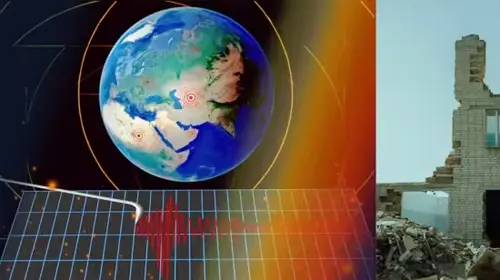Seismology and Earthquake Engineering for Beginners
Seismology, earthquake basics, Earth internal structure,Seismic Wave, Plate Tectonics, Resilient Design, Respose spectra

What you'll learn
Understand the basic concepts of seismology, internal structure of earth, Elastic rebound theory, seismic waves, its propagation and velocity.
Have an idea of plate tectonics, active faults, How do earthquakes occur and their impact of on built environment.
Know about strong-ground-motion measurement using seismographs and accelerographs along with seismic moment, different magnitudes and epicentral distance.
Understand and estimate the ground motion parameters - magnitude, frequency, duration, Peak ground acceleration, velocity and displacement.
Evaluate and apply attenuation equation to find ground motion at site. To know about Soil- structure interaction including soil liquefaction and soil ampl
Understand Sesimic hazard, Seismic risk and seismic loading on structures. How can we reduce seismic risk and what we have learned from the past earthquakes?
Know about response spectrum, it’s important in building design, the different earthquake codes & earthquake design methods for safer structures.
Requirements
No special knowledge needed. No programming/coding required.
Description
This course offers a comprehensive exploration of seismology and earthquake engineering by delving into both theoretical foundations and practical applications. Learners will begin by examining the Earth's internal structure and the elastic rebound theory, gaining an understanding of seismic waves, their propagation, and velocity.
The curriculum then expands into the dynamics of plate tectonics and active faults, detailing the processes that trigger earthquakes and their profound impacts on the built environment.A key component of the course is the analysis of strong-ground-motion measurement techniques using seismographs and accelerographs. Learners will learn to estimate essential ground motion parameters such as magnitude, frequency, duration, peak ground acceleration, peak ground velocity, and peak ground displacement. In addition, the course covers the computation of seismic moment, various magnitude scales, and the significance of epicentral distance.
Advanced topics include the evaluation and application of attenuation equations to determine site-specific ground motion, as well as an in-depth study of soil–structure interaction—addressing issues like soil liquefaction and soil amplification during seismic events. Finally, the course focuses on assessing seismic hazards, risks, and loading on structures, offering strategies to mitigate seismic risk while reflecting on lessons learned from past earthquakes.This interdisciplinary program bridges geophysical principles and engineering practices, preparing learners for careers in seismic hazard assessment, risk reduction, and resilient structural design.
Who this course is for
Civil and geotechnical engineering students
Structural and earthquake engineering students
Graduate engineers who are interested in Earthquake, Seismology and Geothchnical Engineering
Last updated 4/2025
MP4 | Video: h264, 1280x720 | Audio: AAC, 44.1 KHz, 2 Ch
Language: English | Duration: 5h 35m | Size: 1.87 GB
Download
*
Seismology, earthquake basics, Earth internal structure,Seismic Wave, Plate Tectonics, Resilient Design, Respose spectra

What you'll learn
Understand the basic concepts of seismology, internal structure of earth, Elastic rebound theory, seismic waves, its propagation and velocity.
Have an idea of plate tectonics, active faults, How do earthquakes occur and their impact of on built environment.
Know about strong-ground-motion measurement using seismographs and accelerographs along with seismic moment, different magnitudes and epicentral distance.
Understand and estimate the ground motion parameters - magnitude, frequency, duration, Peak ground acceleration, velocity and displacement.
Evaluate and apply attenuation equation to find ground motion at site. To know about Soil- structure interaction including soil liquefaction and soil ampl
Understand Sesimic hazard, Seismic risk and seismic loading on structures. How can we reduce seismic risk and what we have learned from the past earthquakes?
Know about response spectrum, it’s important in building design, the different earthquake codes & earthquake design methods for safer structures.
Requirements
No special knowledge needed. No programming/coding required.
Description
This course offers a comprehensive exploration of seismology and earthquake engineering by delving into both theoretical foundations and practical applications. Learners will begin by examining the Earth's internal structure and the elastic rebound theory, gaining an understanding of seismic waves, their propagation, and velocity.
The curriculum then expands into the dynamics of plate tectonics and active faults, detailing the processes that trigger earthquakes and their profound impacts on the built environment.A key component of the course is the analysis of strong-ground-motion measurement techniques using seismographs and accelerographs. Learners will learn to estimate essential ground motion parameters such as magnitude, frequency, duration, peak ground acceleration, peak ground velocity, and peak ground displacement. In addition, the course covers the computation of seismic moment, various magnitude scales, and the significance of epicentral distance.
Advanced topics include the evaluation and application of attenuation equations to determine site-specific ground motion, as well as an in-depth study of soil–structure interaction—addressing issues like soil liquefaction and soil amplification during seismic events. Finally, the course focuses on assessing seismic hazards, risks, and loading on structures, offering strategies to mitigate seismic risk while reflecting on lessons learned from past earthquakes.This interdisciplinary program bridges geophysical principles and engineering practices, preparing learners for careers in seismic hazard assessment, risk reduction, and resilient structural design.
Who this course is for
Civil and geotechnical engineering students
Structural and earthquake engineering students
Graduate engineers who are interested in Earthquake, Seismology and Geothchnical Engineering
Last updated 4/2025
MP4 | Video: h264, 1280x720 | Audio: AAC, 44.1 KHz, 2 Ch
Language: English | Duration: 5h 35m | Size: 1.87 GB
Download
*